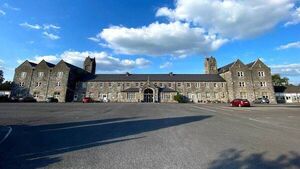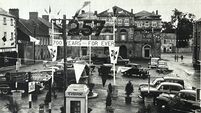The storied history of Athy hospital

St Vincent's Hospital Athy
‘The first phase of the construction of the 92-bed nursing unit for St Vincent’s Hospital, Athy is set for early 2025’. So announced the HSE almost a year ago. The first phase of the construction work aims to deliver 48 beds with subsequent phases to follow.
Detailed design work was, in February of last year, underway for the proposed nursing units. We were advised that efforts were focused on finalising tender packages to be presented to the market for contractors’ selection. Construction activities for the project were then anticipated to commence in the first quarter of 2025.
The last time additional accommodation was provided at the former county home was in 1969, almost 20 years after an interdepartmental committee’s recommendations were adopted by the Irish Government.
The committee set up in 1949 to examine the future of county homes found that many of the former workhouses including Athy’s was still accommodating the chronically sick, the aged and the mentally unstable while lacking appropriate accommodation.
However, the report recognised that the old workhouse buildings could be refurbished to provide accommodation for the aged and chronically sick while the mentally unstable, unmarried mothers and their children should be accommodated in separate institutions.
The report’s recommendations were accepted by the government in 1951, but it was not until 1969 that Kildare County Council approved a scheme of improvement for Athy’s county home by replacing patient accommodation then located on the ground floor and the first floor of the original workhouse building.
The county architect, Niall Meagher, was responsible for the planning, design and construction of the new buildings assisted by Eric Wallace, staff member in the county architect’s department working closely with the Department of Health Architect Cecil Dowdall.
The administration of the project and commissioning, equipping and staffing of the new building involved the then Matron, Sr Dominic.
Work on the construction of the new building by Bantile Limited of Banagher commenced on 27 July 1966 and took almost three years to complete.
The new hospital buildings which cost €250,000 contained two hospital blocks for 100 female patients, three hospital blocks for 168 male patients and 14 maternity unit and delivery rooms.
The new building was occupied on 3 April 1969, 125 years after the workhouse was first opened.
In 1971 the newly established Eastern Health Board took over responsibility for the county home and they named it St Vincent’s Hospital.
The first visiting committee of the board under the chairmanship of cllr Paddy Hickey met in the hospital on 20 May 1971. The following year, the department of health gave approval for the construction of a new convent building, a nurses’ home and a mortuary. The Sisters of Mercy had retained a presence in the former workhouse since 1874 and on their first arrival, they had occupied rooms at the back of the main building.
Later they moved to the front of the building occupying rooms on the first floor and where they remained until they moved into the new convent. The contractors for the new building were Messrs. M. Turley and Co. and in late 1974 the work was completed with buildings officially opened on the 25 June 1975.
In the 1940s, the county home employed three Sisters of Mercy and three nurses and in 1952 the first attendants were employed.
In 2002, despite a reduction in the number of patients in the hospital compared to 50 years previously, the staff employed included 73 nurses, 97 attendants and 10 administrative and support staff.
The Sisters of Mercy who first arrived in Athy in 1851 to teach in the newly opened convent school soon arranged weekly visits to the workhouse and were eventually invited by the Board of Guardians in 1874 to provide nursing sisters for the workhouse.
Thus commenced the Sisters of Mercy’s work in the workhouse, later the county home and then St Vincent’s Hospital. Several members of the Sisters of Mercy were appointed matrons of the county home/St Vincent’s Hospital.
Many of us will remember with fondness the legendary Sr Dominic who was appointed matron in 1957 and succeeded in that position by Sr Peg in 1981. Sr Peg was the last Sister of Mercy to be matron and the last Sister of Mercy to work as a nurse in St. Vincent’s Hospital was Sr Catherine who retired on 31 March 2002.
The dark forbidding building which George Wilkinson had designed in the 1840s has changed beyond recognition in the intervening years.
The corridors which once echoed the shuffling sounds of barefooted men, women and children, have been replaced by modern wards where the elderly and the sick are comforted and cared for with compassion and skill.





